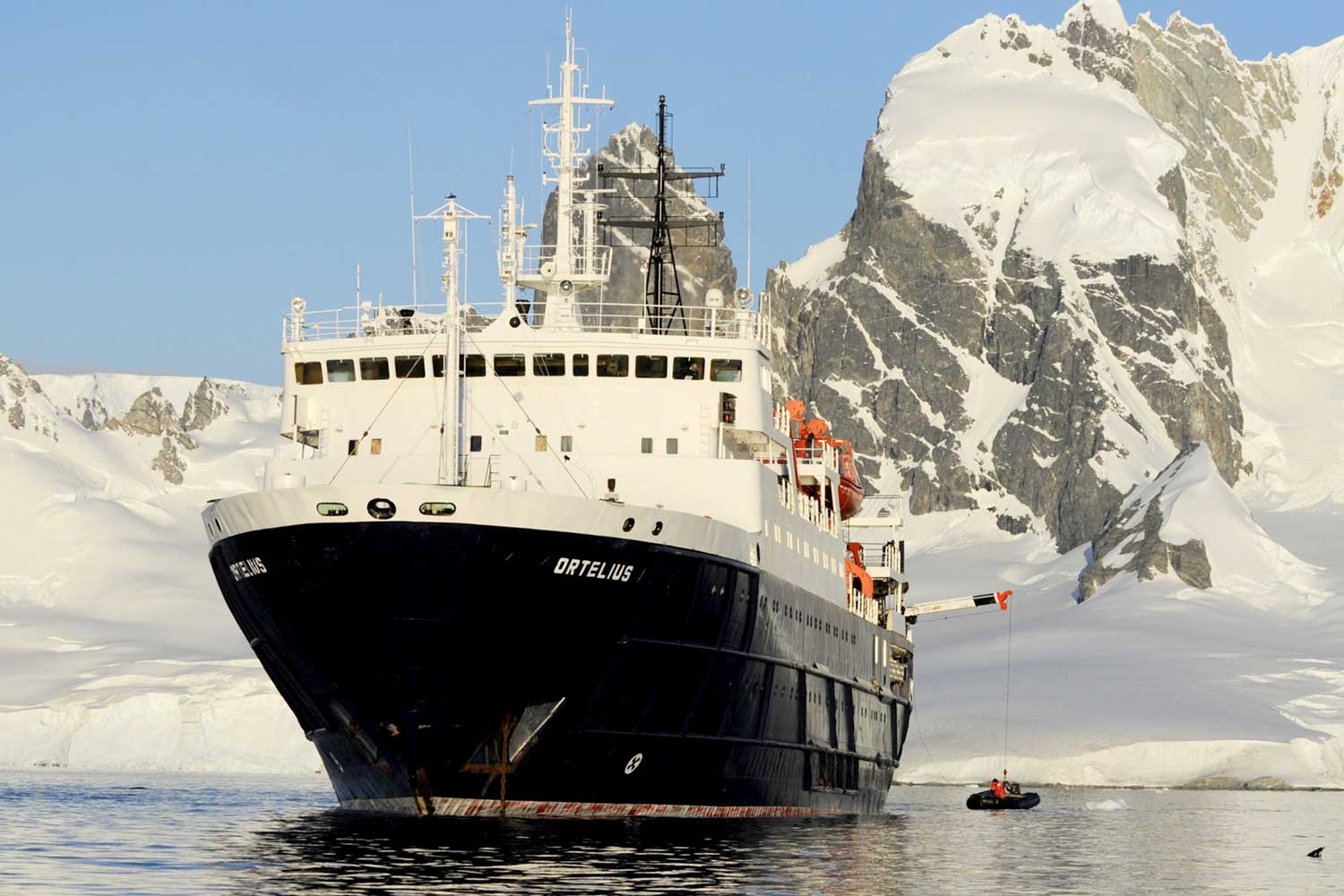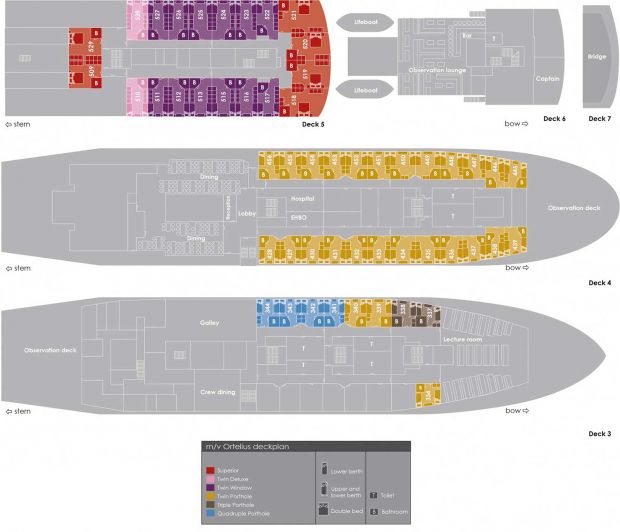Antarctica - Basecamp M/V Ortelius
Antarctic Peninsula
An expedition cruise for adventurers! M/V Ortelius becomes your base camp for this Antarctica cruise. 'Activity modules' are offered which go beyond a normal Antarctic shore program. In this adventurous multi-activity voyage, we visit Antarctica’s Anvers Island and Flandres Bay, where you can learn to chart and make depth measurements while exploring in our Zodiac boats and kayaks. Camping, navigation workshops, and fascinating presentations about historic Antarctic voyages are also part of this immersive expedition
- Activities for everyone: climbing, hiking, kayaking, photography safaris, camping, Zodiac cruises (all activities free of charge)
- Camp near the penguin colonies
- Observe wildlife from your kayak
- Flora and fauna of Antarctic Peninsula
- Antarctic Peninsula’s magical scenery

Stewart's Take
Choose from many included adventure options that normally cost extra!
Overview
An expedition cruise for adventurers! M/V Ortelius becomes your base camp for this Antarctica cruise. 'Activity modules' are offered which go beyond a normal Antarctic shore program. In this adventurous multi-activity voyage, we visit Antarctica’s Anvers Island and Flandres Bay, where you can learn to chart and make depth measurements while exploring in our Zodiac boats and kayaks. Camping, navigation workshops, and fascinating presentations about historic Antarctic voyages are also part of this immersive expedition.Scrolling is disabled on map, please click to enable.
Expedition Vessel: M/V Ortelius

The ice-strengthened vessel Ortelius is an excellent vessel for Polar expedition cruises in the Arctic and Antarctica, providing possibilities to adventure in remote locations such as the Ross Sea and Franz Josef Land. Ortelius was built in Gdynia, Poland in 1989, was named Marina Svetaeva, and served as a special purpose vessel for the Russian Academy of Science. The vessel is now re-flagged and renamed Ortelius. She offers a comfortable hotel standard, with two restaurants, a bar/lecture room and a sauna. Her voyages are primarily developed to offer our passengers a quality exploratory wildlife program, trying to spend as much time ashore as possible. As the number of passengers is limited to approximately 106, flexibility assures maximum wildlife opportunities.

- Voyage aboard the designated vessel as indicated in the itinerary.
- All meals throughout the voyage aboard the ship including snacks, coffee and tea.
- Free use of rubber boots
- Pre-scheduled group transfer from the vessel to the airport in Ushuaia (directly after disembarkation).
- All shore excursions and activities throughout the voyage by Zodiac.
- Program of lectures by noted naturalists and leadership by experienced expedition staff.
- All miscellaneous service taxes and port charges throughout the program.
- Comprehensive pre-departure material.
- Any airfare whether on scheduled or charter flights.
- Pre- and post land arrangements.
- Transfers to the vessel.
- Passport and visa expenses.
- Government arrival and departure taxes.
- Meals ashore.
- Baggage, cancellation and personal insurance (which is strongly recommended).
- Excess baggage charges.
- All items of a personal nature such as laundry, bar, beverage charges and telecommunication charges.
- The customary gratuity at the end of the voyages for stewards and other service personnel aboard (guidelines will be provided).
- Possible fuel surcharges; It is agreed that if world fuel prices will reach or exceed US Dollar 120 per Barrel Brent 90 days prior to departure Oceanwide Expeditions reserves the right to levy a fuel surcharge of US $ 25 per passenger per night for bookings outside Europe and EURO 18 per passenger per night for bookings within Europe, to be paid by the contracting party of Oceanwide Expeditions.

Tour Dossier
Antarctica - Basecamp M/V Ortelius

An Antarctic expedition cruise onboard M/V Ortelius with a greater variety of included activities such as climbing, kayaking, hiking and diving
File Creation date: 2024-04-25 - for updated information and dates and prices see the following page:
http://expeditionsonline.com/tour/antarctic-basecamp-mv-ortelius_69

Antarctica - Basecamp M/V Ortelius
Duration: 13 days
Location: Antarctic Peninsula
Available: November-March
Start: Ushuaia, Argentina
Finish: Ushuaia, Argentina

Highlights
- Activities for everyone: climbing, hiking, kayaking, photography safaris, camping, Zodiac cruises (all activities free of charge)
- Camp near the penguin colonies
- Observe wildlife from your kayak
- Flora and fauna of Antarctic Peninsula
- Antarctic Peninsula’s magical scenery

Itinerary
An expedition cruise for adventurers! M/V Ortelius becomes your base camp for this Antarctica cruise. 'Activity modules' are offered which go beyond a normal Antarctic shore program. In this adventurous multi-activity voyage, we visit Antarctica’s Anvers Island and Flandres Bay, where you can learn to chart and make depth measurements while exploring in our Zodiac boats and kayaks. Camping, navigation workshops, and fascinating presentations about historic Antarctic voyages are also part of this immersive expedition





Ship Information
Expedition Vessel: M/V Ortelius

The ice-strengthened vessel Ortelius is an excellent vessel for Polar expedition cruises in the Arctic and Antarctica, providing possibilities to adventure in remote locations such as the Ross Sea and Franz Josef Land. Ortelius was built in Gdynia, Poland in 1989, was named Marina Svetaeva, and served as a special purpose vessel for the Russian Academy of Science. The vessel is now re-flagged and renamed Ortelius. She offers a comfortable hotel standard, with two restaurants, a bar/lecture room and a sauna. Her voyages are primarily developed to offer our passengers a quality exploratory wildlife program, trying to spend as much time ashore as possible. As the number of passengers is limited to approximately 106, flexibility assures maximum wildlife opportunities.

Antarctica - Basecamp M/V Ortelius
For the latest, up-to-date departure dates and prices please refer to the tour page:
http://expeditionsonline.com/tour/antarctic-basecamp-mv-ortelius_69
Included
- Voyage aboard the designated vessel as indicated in the itinerary.
- All meals throughout the voyage aboard the ship including snacks, coffee and tea.
- Free use of rubber boots
- Pre-scheduled group transfer from the vessel to the airport in Ushuaia (directly after disembarkation).
- All shore excursions and activities throughout the voyage by Zodiac.
- Program of lectures by noted naturalists and leadership by experienced expedition staff.
- All miscellaneous service taxes and port charges throughout the program.
- Comprehensive pre-departure material.
Excluded
- Any airfare whether on scheduled or charter flights.
- Pre- and post land arrangements.
- Transfers to the vessel.
- Passport and visa expenses.
- Government arrival and departure taxes.
- Meals ashore.
- Baggage, cancellation and personal insurance (which is strongly recommended).
- Excess baggage charges.
- All items of a personal nature such as laundry, bar, beverage charges and telecommunication charges.
- The customary gratuity at the end of the voyages for stewards and other service personnel aboard (guidelines will be provided).
- Possible fuel surcharges; It is agreed that if world fuel prices will reach or exceed US Dollar 120 per Barrel Brent 90 days prior to departure Oceanwide Expeditions reserves the right to levy a fuel surcharge of US $ 25 per passenger per night for bookings outside Europe and EURO 18 per passenger per night for bookings within Europe, to be paid by the contracting party of Oceanwide Expeditions.

General Terms and Conditions
Expeditions Online Newsletter
Sign up to be an Expeditions Online insider and receive info on exclusive deals, discounts and more!